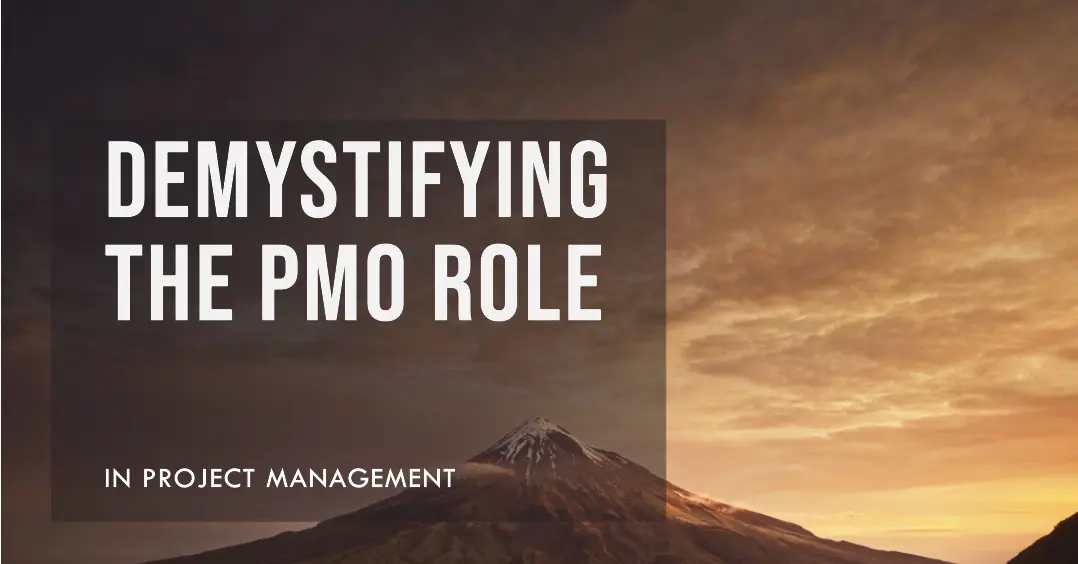I. Introduction
Hello, fellow project management enthusiasts! Have you ever wondered about the secret sauce behind successful projects? Today, we’re going to explore one of the key players in project management: the PMO, or Project Management Office. If you’re new to this concept or you’ve heard of it but aren’t quite sure what it does, you’re in the right place. We’ll demystify the PMO role and highlight the differences between a PMO and a project manager. So, grab a cup of coffee, and let’s dive in!
A. Brief overview of the importance of project management
Before we get into the nitty-gritty of the PMO role, let’s take a moment to appreciate the significance of project management. Whether you’re developing a new software application, launching a marketing campaign, or building a skyscraper, every project needs a solid structure and a well-defined process. Effective project management helps organizations deliver high-quality results on time and within budget, ensuring the satisfaction of stakeholders and fostering business growth.
B. Introduction to PMO (Project Management Office) and its role
Now, let’s talk about the PMO. In a nutshell, the PMO is an organizational unit that helps ensure the successful execution of projects by providing support, guidance, and oversight. The PMO is like a guardian angel, watching over projects and ensuring they run smoothly from inception to completion. It’s responsible for aligning projects with the organization’s strategic goals, managing resources, monitoring performance, and much more.
C. Clarification of the differences between PMO and project manager
At this point, you might be wondering, “How is a PMO different from a project manager?” It’s a great question! While both roles are crucial to project management, they have distinct functions and responsibilities. The PMO focuses on an organization’s overall project management processes and practices, whereas a project manager is directly responsible for the planning, execution, and closure of individual projects.
In the upcoming sections, we’ll delve deeper into the core responsibilities of a PMO and further explore the differences between a PMO and a project manager. So, buckle up and stay tuned for a thrilling ride through the world of project management!
II. The Core Responsibilities of a PMO
In this section, we’ll take a closer look at the main responsibilities of a PMO. These are the critical areas where a PMO adds value to an organization’s project management efforts. Let’s explore them one by one, so you can better understand how a PMO can make a significant difference in your organization.
A. Strategic planning and alignment
- Portfolio management
A PMO plays a pivotal role in managing an organization’s project portfolio. It’s like a skilled conductor, orchestrating multiple projects to ensure they align with the company’s strategic objectives. By overseeing the entire project landscape, the PMO can identify dependencies, synergies, and potential bottlenecks, helping the organization make informed decisions about project prioritization.
- Prioritization of projects
With so many projects competing for limited resources, it’s essential to know which ones should be prioritized. The PMO serves as an unbiased decision-maker, considering factors like strategic alignment, ROI, risk, and resource availability to determine the optimal order for executing projects.
- Ensuring alignment with business objectives
The PMO is like a strategic compass, guiding projects to align with the organization’s broader goals. By providing a clear vision and ensuring that each project contributes to the overall mission, the PMO helps maintain focus and maximizes the value of project investments.
B. Governance and compliance
- Implementing and maintaining project management methodologies
One of the PMO’s key responsibilities is to establish and maintain project management methodologies, processes, and best practices. The PMO ensures that everyone speaks the same project management language, creating consistency and fostering a culture of continuous improvement.
- Ensuring project quality and compliance
The PMO acts as a quality assurance agent, ensuring that projects adhere to the organization’s policies, standards, and regulatory requirements. By monitoring project performance and conducting regular audits, the PMO helps maintain high-quality deliverables and minimizes risks.
- Monitoring and controlling project risks
Risk management is an essential component of successful project management. The PMO helps identify, assess, and mitigate project risks, keeping projects on track and avoiding potential pitfalls.
C. Resource management
- Talent acquisition and development
A PMO is responsible for recruiting, developing, and retaining skilled project management professionals. By providing training, mentorship, and career development opportunities, the PMO helps cultivate a high-performing project management team.
- Resource allocation
The PMO plays a critical role in allocating resources effectively across the organization’s projects. It ensures that the right people, tools, and equipment are available when needed, optimizing resource utilization and preventing over- or under-allocation.
- Capacity planning
By forecasting resource needs and maintaining a resource capacity plan, the PMO helps organizations anticipate and address resource constraints, enabling smooth project execution and avoiding potential delays.
D. Financial management
- Budgeting and forecasting
The PMO is responsible for developing and managing project budgets, ensuring that projects are adequately funded and financial resources are allocated wisely. Through careful forecasting, the PMO helps organizations predict and plan for future project expenditures.
- Financial tracking and reporting
A PMO keeps a close eye on project finances, tracking costs and comparing them against budgets. By providing regular financial reports, the PMO enables stakeholders to make informed decisions and take corrective action when necessary.
- Cost control and optimization
By identifying cost-saving opportunities and promoting efficiency, the PMO helps organizations optimize their project investments and maximize ROI.
E. Performance measurement and reporting
- Key performance indicators (KPIs)
The PMO defines and tracks relevant KPIs to monitor the performance of projects and the project management function as a whole. This data-driven approach ensures that decisions are based on facts and helps drive continuous improvement in project management processes.
- Progress reporting and communication
Communication is crucial for successful project management. The PMO facilitates regular progress reporting, keeping stakeholders informed about project status, risks, and issues. By fostering transparency and open communication, the PMO helps build trust and maintain stakeholder buy-in.
- Continuous improvement
A PMO is never satisfied with the status quo. It constantly evaluates project performance and the effectiveness of its own processes, seeking opportunities for improvement. By promoting a culture of learning and innovation, the PMO helps organizations adapt and evolve in a rapidly changing business environment.
So, there you have it! These are the core responsibilities of a PMO and how it can drive success in your organization’s project management efforts. By providing strategic direction, ensuring quality and compliance, managing resources, and monitoring performance, a PMO is an invaluable partner in the quest for project excellence. Stay tuned as we dive into the key differences between a PMO and a project manager in the next section!
III. The Key Differences Between a PMO and a Project Manager
Now that we’ve explored the critical responsibilities of a PMO, let’s dive into the differences between a PMO and a project manager. Understanding these distinctions will help you appreciate the unique roles each plays in project management and how they complement each other.
A. Scope of responsibility
- PMO’s organization-wide focus
The PMO has a bird’s-eye view of the entire organization’s projects, ensuring that they align with strategic goals, follow best practices, and effectively utilize resources. The PMO takes on a broader role, encompassing multiple projects and working to optimize the organization’s overall project management function.
- Project manager’s specific project focus
On the other hand, a project manager is directly responsible for the planning, execution, and closure of individual projects. Their focus is narrower, as they work on specific projects, leading teams, and ensuring that project objectives are met within the given constraints, such as time, budget, and quality.
B. Role in project execution
- PMO’s supportive and strategic function
The PMO serves a supportive and strategic role, providing guidance, resources, and oversight to project managers and teams. They establish and maintain project management methodologies, manage project portfolios, and ensure that projects are aligned with organizational objectives.
- Project manager’s direct involvement in project delivery
The project manager is directly involved in project delivery, leading the team and coordinating tasks to achieve project goals. They manage stakeholder expectations, handle risk management, and are accountable for the project’s success or failure.
C. Reporting and decision-making authority
- PMO’s role in steering committees and executive boards
The PMO often participates in steering committees and executive boards, providing crucial input on strategic decisions, resource allocation, and project prioritization. The PMO’s influence on decision-making is typically organization-wide and long-term.
- Project manager’s direct communication with project stakeholders
A project manager communicates directly with project stakeholders, including sponsors, team members, and customers, keeping them informed about project status, risks, and issues. They are responsible for making day-to-day decisions to ensure the project stays on track and meets its objectives.
By understanding the differences between a PMO and a project manager, you can see how these two roles complement each other in the pursuit of project excellence. The PMO provides strategic guidance and support, while the project manager focuses on the hands-on execution of individual projects. Together, they form a powerful partnership, ensuring that projects are completed on time, within budget, and to the satisfaction of all stakeholders. In the next section, we’ll discuss the value that a PMO brings to project management, so stay tuned!
IV. The Value of PMO in Project Management
We’ve come a long way in our exploration of the PMO and its role in project management. Now, let’s take a moment to appreciate the true value that a PMO brings to the table. By understanding its impact, you’ll be better equipped to champion the adoption of a PMO in your organization or leverage its potential if you already have one in place.
A. Improved project success rates
One of the most significant benefits of a PMO is its contribution to improving project success rates. By implementing consistent project management methodologies, providing strategic guidance, and monitoring performance, the PMO helps reduce project risks, delays, and failures. With a PMO in place, your organization is more likely to deliver projects on time, within budget, and with high-quality results.
B. Enhanced resource allocation and utilization
Effective resource management is crucial for project success. The PMO plays a pivotal role in optimizing resource allocation across the organization’s projects, ensuring that the right people, tools, and equipment are available when needed. This not only prevents resource conflicts and bottlenecks but also enhances productivity and efficiency.
C. More effective decision-making and governance
The PMO’s involvement in strategic planning and decision-making helps organizations make informed choices about project prioritization, resource allocation, and risk management. By providing data-driven insights and a comprehensive view of the project landscape, the PMO enables leaders to make better decisions and steer the organization toward its goals.
D. Standardization and efficiency in project management processes
A PMO fosters consistency and efficiency in project management processes by implementing and maintaining best practices, tools, and templates. This standardization helps project teams work more effectively, reduces duplication of effort, and promotes a culture of continuous improvement. With a PMO in place, your organization can streamline its project management function and become more agile and responsive.
In conclusion, a PMO is a powerful asset in the world of project management, driving success by improving project outcomes, optimizing resource utilization, enhancing decision-making, and promoting standardization and efficiency. By recognizing and leveraging the value of a PMO, your organization can elevate its project management capabilities and achieve greater success.
V. Conclusion
And there you have it, my fellow project management aficionados! We’ve explored the fascinating world of the PMO, delving into its core responsibilities, differentiating it from the project manager role, and highlighting the immense value it brings to project management.
A. Recap of the PMO’s role and its importance in project management
To sum it up, the PMO serves as a strategic partner, ensuring that your organization’s projects are aligned with business objectives, efficiently managed, and delivered with quality. Its involvement in portfolio management, governance, resource allocation, financial management, and performance measurement is invaluable in driving project success and improving your organization’s project management capabilities.
B. Encouragement for organizations to adopt and leverage a PMO for improved project success
If your organization doesn’t have a PMO yet, it’s worth considering the adoption of this powerful function to boost your project management prowess. And if you’re already working with a PMO, remember to tap into its full potential by leveraging its expertise, resources, and insights.
Thank you for joining me on this exciting journey through the world of PMOs! I hope this deep dive has provided you with valuable insights and a better understanding of the PMO’s role in project management. As you move forward in your project management adventures, may the power of the PMO be with you, guiding your projects to success and helping your organization thrive. Happy project managing!
To find out how Artificial Intelligence is changing the Project Management landscape, you have enjoy reading this article https://www.shaunstoltz.com/did-artificial-intelligence-just-change-everything-about-project-management/
Find out more about Shaun Stoltz https://www.shaunstoltz.com/about/
This post was written by an AI and reviewed/edited by a human.



